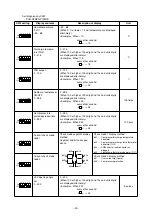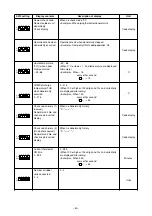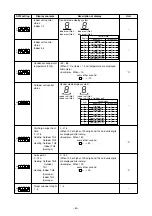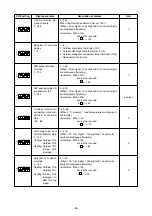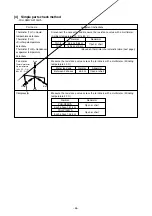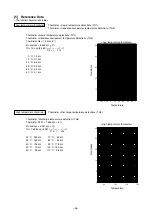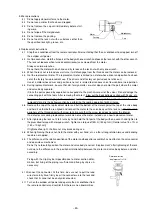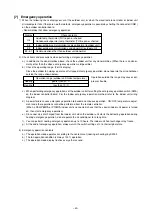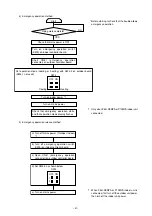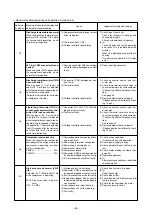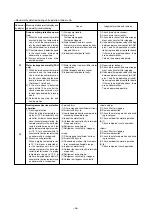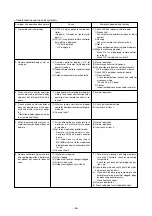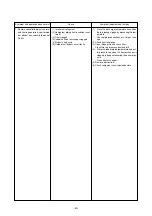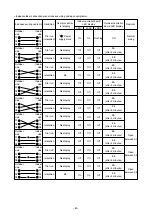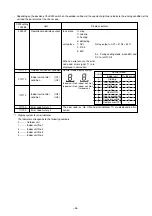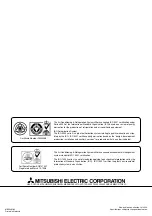
–43–
<Abnormality detected during unit operation: Outdoor unit>
Abnormal-
ity display
U2
U3
U4
U6
UE
Meaning of abnormality display and
abnormality troubleshooting
Discharge temperature abnormal
When the discharge thermistor tem-
perature (TH2) exceeds 118
°
C while
the compressor is operating, an ab-
normality is recognized.
49C trip (CN23 connector discon-
nected)
When connector CN23 opens while
the compressor is operating, an ab-
normality is recognized.
Discharge temp thermistor (TH2)
open or shorted.
When an open (0
°
C or lower) or
short (216
°
C or higher) is detected
while the compressor is operating, an
abnormality is recognized.
(Detection is disabled for 5 minutes
at compressor starting.)
Liquid temp thermistor (TH1) or
condenser/evaporater temp ther-
mistor (TH3) open or shorted.
When an open (–39
°
C or lower) or
short (88
°
C or higher) is detected
while the compressor is operating, an
abnormality is recognized. (Detection
is disabled for 7 minutes beginning
from 10 seconds after the compres-
sor starts and for 10 minutes after
return from defrosting.)
Compressor overcurrent trip
When the current value reaches the
overload set value or higher while the
compressor is operating, an abnor-
mality is recognized.
P8MYA .................................. 22 A
P10MYA ................................ 27 A
High pressure abnormal (63H1
trip)
Detected (3.3
+0
-0.15
MPa) by 63H1 trip
while compressor is operating.
63H1: Pressure switch (high pres-
sure)
OFF: 3.3 MPa
Cause
(1) Compressor overheating due to insuf-
ficient refrigerant.
(2) Thermistor faulty. (TH2)
(3) Outdoor controller board faulty.
(1) Shorting connector CN23 on outdoor
controller board dislodged or contact
faulty.
(1) Connector (CN3) dislodged or con-
nect faulty.
(2) Thermistor faulty.
(3) Outdoor controller board faulty.
(1) Connector (TH1: CN2, TH3: CN4) dis-
lodged or contact faulty.
(2) Thermistor faulty.
(3) Outdoor controller board faulty.
(1) Overload operation exceeding unit us-
age range limit.
(2) Power supply terminal voltage low.
(3) Power supply missing phase.
(4) Compressor motor faulty.
(5) Compressor locked.
(6) Connector (CN22) on outdoor control-
ler board dislodged or contact faulty.
(7) 51C disconnected or contact faulty.
(1) Started with ball valve closed.
(2) Connector (CN21) on outdoor control-
ler board dislodged or contact faulty.
(3) 63H1 disconnected or contact faulty.
(4) Indoor filter clogged. Power reset de-
tected during heating overload opera-
tion (Heating).
(5) Low indoor unit air flow (heating).
(6) Low outdoor unit air flow (cooling).
(7) Part faulty.
Judgment method and remedy
(1) Check input super heat.
Check for refrigerant leakage and
check piping length.
Charge with additional refrigerant.
(2)(3)
Turn off power and restart operation
and check if U3 is displayed within 8
minutes.
When U3 is displayed, carry out U3 pro-
cessing.
(Do not replace board at U2 display
only.)
(1) Repair shorting connector.
(1) Check connector contact and ther-
mistor wire.
(2) Check thermistor resistance value, or
check temperature by microcomputer.
(Check using SW2 self-diagnosis func-
tion.)
See page 36.
(3) Replace outdoor controller board.
(Replace board after sufficiently check-
ing 1 and 2.)
(1) Check connector contact and ther-
mistor wire.
(2) Check thermistor resistance value or
check temperature by microcomputer.
(Check using SW2 self-diagnosis func-
tion.)
See to page 36.
(3) Replace outdoor controller board.
(Replace board after sufficiently check-
ing 1 and 2)
(1) Check usage conditions.
(Check for short cycle operation.)
(2) Check power supply voltage.
(3) Check wiring for breaks and faulty con-
tact.
(4) Check motor winding resistance (See
page 35.)
(5) Replace compressor.
(6)(7)
After checking connections, restart and
check operation.
(1) Check if ball valve is fully open.
(2)(3)
Repair connector.
(4) Check indoor filter.
(5) Check flow duct static pressure and for
faulty fan motor.
(6) Check for faulty outdoor fan motor.
(7) Replace pressure switch.

